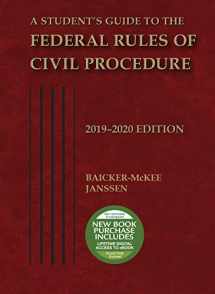
A Student's Guide to the Federal Rules of Civil Procedure, 2019-2020 (Selected Statutes)
ISBN-13:
9781684672202
ISBN-10:
1684672201
Edition:
2019
Author:
William M. Janssen, Steven F. Baicker-McKee
Publication date:
2019
Publisher:
West Academic Publishing
Format:
Paperback
860 pages
Category:
Civil Procedure
,
Rules & Procedures
FREE US shipping
Book details
ISBN-13:
9781684672202
ISBN-10:
1684672201
Edition:
2019
Author:
William M. Janssen, Steven F. Baicker-McKee
Publication date:
2019
Publisher:
West Academic Publishing
Format:
Paperback
860 pages
Category:
Civil Procedure
,
Rules & Procedures
Summary
A Student's Guide to the Federal Rules of Civil Procedure, 2019-2020 (Selected Statutes) (ISBN-13: 9781684672202 and ISBN-10: 1684672201), written by authors
William M. Janssen, Steven F. Baicker-McKee, was published by West Academic Publishing in 2019.
With an overall rating of 4.5 stars, it's a notable title among other
Civil Procedure
(Rules & Procedures) books. You can easily purchase or rent A Student's Guide to the Federal Rules of Civil Procedure, 2019-2020 (Selected Statutes) (Paperback, Used) from BooksRun,
along with many other new and used
Civil Procedure
books
and textbooks.
And, if you're looking to sell your copy, our current buyback offer is $0.35.
Description
Receive complimentary lifetime digital access to the eBook with new print purchase.
What Makes A Student's Guide to the Federal Rules of Civil Procedure Different?
What Makes A Student's Guide to the Federal Rules of Civil Procedure Different?
- Text of the Rules, Title 28, and Constitution: The 2019-2020 edition supplies what your students need―the text of the Federal Rules of Civil Procedure (as amended through December 1, 2018), the frequently-consulted sections of the U.S. Judiciary Code, and the text of the U.S. Constitution. Most Rules Supplements available to students contain that same content. But where most supplements stop, A Student’s Guide continues on….
-
PLUS… Student-Friendly Orientation to Each Rule: What many students often find challenging in studying Civil Procedure―and what is less likely to be found in either a casebook or a conventional study aid―is an understanding of how each Rule "fits" into the master scheme of federal civil practice generally. This edition of A Student’s Guide offers students that very guidance. Three features follow the text of each Rule:
- "How This Rule Fits In" explains for students the broad context of each Rule and the role each plays in federal civil practice;
- "The Architecture of this Rule" guides students in unpacking the structure of those Rules that are especially long and confusing;
- “How This Rule Works in Practice” helps students understand each Rule’s application, subpart by subpart, in the real-world, practical life of practicing attorneys.
- PLUS… Citations to Interpretative Case Law: Also unlike most other Rules Supplements, A Student's Guide provides students with select, leading interpretative case law analyzing the Rules and their subparts. This, then, converts this resource into a "finding aid” of sorts, as students work through applied problems in the context of the Rules.
- PLUS… A “Getting Started” Overview to Federal Practice Concepts: Because many of the related core concepts of federal practice are an amalgam of law found in Rules, statutes, constitutional provisions, and case law, A Student's Guide bridges that gulf with quick, orienting discussions of central practice concepts like personal jurisdiction, subject-matter jurisdiction, removal, venue, forum non conveniens, the Erie Doctrine, and claim and issue preclusion. These distillations allow students to acquire a broad view of those related practice contexts.
- PLUS… A Handy Overview of Federal Appellate Practice: This edition of A Student’s Guide also includes a concise, student-friendly overview of federal appellate practice.
- PLUS… A Helpful Orientation to the Rulemaking Process: A Student’s Guide also includes a brief orientation for students to the process of federal rulemaking, how the Rules originally came into existence, and how they are amended.


We would LOVE it if you could help us and other readers by reviewing the book
Book review

Congratulations! We have received your book review.
{user}
{createdAt}
by {truncated_author}


